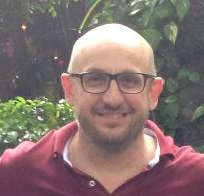IEEE LATINCOM 2019 will host the following tutorials for all attendees with a registration.
Tutorial 1
Title: eHealth Technologies with Mobility Support
Outline: This Tutorial will focus on a hot topic on e-health technologies considering their recent advances, including Internet of Things and mobile technologies for mobility environments. Information and communication technologies have rapidly grown in the last decades along with mobile Internet concept of anywhere and anytime connection. In this context, Mobile Health (m-Health) proposes to deliver healthcare services, overcoming geographical, temporal and even organizational barriers. Pervasive and m-Health services aim to respond several emerging problems in health services, including, the increasing number of chronic diseases related to lifestyle, high costs in existing national health services, the need to empower patients and families to self-care and manage their own healthcare, and the need to provide direct access to health services, regardless of time and place. This keynote will address the most relevant contributions for healthcare, e-health systems, and ambient assisted living (including sensor networks, Internet of Things, and mobile computing), focusing on the mobile health revolution and evolution. Trends and insights on future research works are also considered.
 Joel J. P. C. Rodrigues [S’01, M’06, SM’06] is a professor at the Federal University of Piauí, Brazil; and senior researcher at the Instituto de Telecomunicações, Portugal. Prof. Rodrigues is the leader of the Internet of Things research group (CNPq), Director for Conference Development – IEEE ComSoc Board of Governors, IEEE Distinguished Lecturer, Technical Activities Committee Chair of the IEEE ComSoc Latin America Region Board, the President of the scientific council at ParkUrbis – Covilhã Science and Technology Park, the Past-Chair of the IEEE ComSoc Technical Committee on eHealth, the Past-chair of the IEEE ComSoc Technical Committee on Communications Software, Steering Committee member of the IEEE Life Sciences Technical Community and Publications co-Chair, and Member Representative of the IEEE Communications Society on the IEEE Biometrics Council. He is the editor-in-chief of the International Journal on E-Health and Medical Communications and editorial board member of several high-reputed journals. He has been general chair and TPC Chair of many international conferences, including IEEE ICC, IEEE GLOBECOM, IEEE HEALTHCOM, and IEEE LatinCom. He has authored or coauthored over 780 papers in refereed international journals and conferences, 3 books, 2 patents, and 1 ITU-T Recommendation. He had been awarded several Outstanding Leadership and Outstanding Service Awards by IEEE Communications Society and several best papers awards. Prof. Rodrigues is a member of the Internet Society, and a senior member ACM and IEEE.
Joel J. P. C. Rodrigues [S’01, M’06, SM’06] is a professor at the Federal University of Piauí, Brazil; and senior researcher at the Instituto de Telecomunicações, Portugal. Prof. Rodrigues is the leader of the Internet of Things research group (CNPq), Director for Conference Development – IEEE ComSoc Board of Governors, IEEE Distinguished Lecturer, Technical Activities Committee Chair of the IEEE ComSoc Latin America Region Board, the President of the scientific council at ParkUrbis – Covilhã Science and Technology Park, the Past-Chair of the IEEE ComSoc Technical Committee on eHealth, the Past-chair of the IEEE ComSoc Technical Committee on Communications Software, Steering Committee member of the IEEE Life Sciences Technical Community and Publications co-Chair, and Member Representative of the IEEE Communications Society on the IEEE Biometrics Council. He is the editor-in-chief of the International Journal on E-Health and Medical Communications and editorial board member of several high-reputed journals. He has been general chair and TPC Chair of many international conferences, including IEEE ICC, IEEE GLOBECOM, IEEE HEALTHCOM, and IEEE LatinCom. He has authored or coauthored over 780 papers in refereed international journals and conferences, 3 books, 2 patents, and 1 ITU-T Recommendation. He had been awarded several Outstanding Leadership and Outstanding Service Awards by IEEE Communications Society and several best papers awards. Prof. Rodrigues is a member of the Internet Society, and a senior member ACM and IEEE.
Tutorial 2
Title: Aspects of AI-based applications in 5G networks
Outline: Fifth-generation cellular network technology (5G) embraces massive data transmission and ubiquitous connectivity, where extreme service demands require more efficient network architectures to guarantee the lowest delay vs. highest throughput trade-off. Such complex architectures bring several challenges (e.g. automated networks operation, big data handling, etc) to achieve cost-efficient deployments. AI techniques can help tackling these challenges through network automation and by enabling new applications and use cases. The main objective of this tutorial is to go through the motivations and challenges regarding the adoption of AI in various network scenarios and 5G applications, both discussing technical details of ML usage in 5G scenarios and showing some real examples under investigation by the authors and other researchers in both academia and industry.
 Silvia Lins is an Experienced Researcher in the Network Architecture and Protocols area at Ericsson Research, Indaiatuba, Brazil. Currently, her research involves machine learning applied to congestion control algorithms and 5G use cases focused on equipment inspection through computer vision. In the past, she also worked with Information-centric networks and LTE mobile networks. Silvia holds a B.Sc. in Computer Engineering and an M.Sc. in Electrical Engineering at the Federal University of Pará in Brazil, where she is also doing her Ph.D. in Telecommunications.
Silvia Lins is an Experienced Researcher in the Network Architecture and Protocols area at Ericsson Research, Indaiatuba, Brazil. Currently, her research involves machine learning applied to congestion control algorithms and 5G use cases focused on equipment inspection through computer vision. In the past, she also worked with Information-centric networks and LTE mobile networks. Silvia holds a B.Sc. in Computer Engineering and an M.Sc. in Electrical Engineering at the Federal University of Pará in Brazil, where she is also doing her Ph.D. in Telecommunications.
 Pedro Henrique Gomes is an Experienced Researcher at Ericsson Research Brazil, engaged in orchestration and automation of 5G network services. He is a delegate in the ETSI Zero-Touch Network & Service Management (ZSM) working group, contributing to the architecture definition especially with AI and ML concepts, and driving the specification of enablers for Closed-Loop Automation in end-to-end network services. He received his Ph.D. (2019) in electrical engineering from the University of Southern California, USA, and his M.Sc. (2011) in computer science from the University of Campinas, Brazil.
Pedro Henrique Gomes is an Experienced Researcher at Ericsson Research Brazil, engaged in orchestration and automation of 5G network services. He is a delegate in the ETSI Zero-Touch Network & Service Management (ZSM) working group, contributing to the architecture definition especially with AI and ML concepts, and driving the specification of enablers for Closed-Loop Automation in end-to-end network services. He received his Ph.D. (2019) in electrical engineering from the University of Southern California, USA, and his M.Sc. (2011) in computer science from the University of Campinas, Brazil.
Tutorial 3
Title: Applications of Multi-User Technologies on IEEE 802.11ac (Wi-Fi 5), 802.11ax (Wi-Fi 6) and 802.11be (Extremely High Throughput) Amendments
Outline The theoretical peak physical layer (PHY) rate specified in the 2013 IEEE 802.11ac amendment of 6.4 Gbps does not provide the same throughput at the medium access control (MAC) service access point (SAP). Hence, the IEEE Task Group (TG) 802.11ax, created on May 2014, has been developing the sixth generation (6G) of wireless local area networks (WLANs) targeting improving the spectrum efficiency and area throughput of 5-10 times in ultra-dense networks deployed in both indoor and outdoor environments. The 802.11ax Work Group forecasts the approval of the 802.11ax amendment by January 2020.
The increasing digitalization of our society has been driven that the Wi-Fi community continues the development of new technologies to cope with applications that demand high-throughput and low-latency, such as, virtual reality (AR) and augmented reality (AR). The aforementioned issues has lead to the creation of the IEEE 802.11be TG on May 2019 to develop a backward-compatible amendment for the 7G of WLANs (Wi-Fi 7) that enables new MAC and PHY modes of operation capable of supporting a maximum throughput of at least 30 Gbps, measured at MAC SAP (i.e., 4x w.r.t the IEEE 802.11ax amendment) using carrier frequencies between 1.0 and 7.125 GHz,
The main objectives of this tutorial are summarized as follows:
- To provide a solid background on the evolution of standards and amendments developed by IEEE 802.11 standardization committee (SC).
- To describe the main characteristics of the IEEE 802.11 MAC protocols.
- To substantiate a clear understanding of the motivations and usage cases that have been driven the development of the IEEE 802.11ax (Wi-Fi 6) and 802.11be (Wi-Fi 7) amendments.
- To establish a deep understanding of the main MAC and PHY layer protocols and technologies that have been researched in the Task Group (TG) IEEE 802.11ax.
- To present and discuss research directions on WLANs based on the initial studies that have been developed in TG 802.11be.
- Performance analyzes of downlink (DL) and uplink (UL) multi-user multiple-input multiple-output (MU-MIMO) technologies with realistic channel state information (CSI) and hardware impairments.
 Roger Pierre Fabris Hoefel is an Associate Professor at Department of Electrical Engineering of Federal University of Rio Grande do Sul (UFRGS), Porto Alegre, Rio Grande do Sul, Brazil. He received the degree of Doctor in Electrical Engineering by State University of Campinas (UNICAMP), Campinas, São Paulo, Brazil, in 2000; Master in Computer Science by UFRGS in 1994; Post-Graduated in Electronic Instrumentation by Federal University of Santa Catarina (UFSC), Florianópolis, Santa Catarina, Brazil, in 1991; Bachelor in Electrical Engineering by Pontific Catholic University of Rio Grande do Sul (PUC-RS), Porto Alegre, Rio Grande do Sul, Brazil, in 1990. His current research interest includes design, analyzes and optimization of algorithms for physical and medium access control layers of wireless networks.
Roger Pierre Fabris Hoefel is an Associate Professor at Department of Electrical Engineering of Federal University of Rio Grande do Sul (UFRGS), Porto Alegre, Rio Grande do Sul, Brazil. He received the degree of Doctor in Electrical Engineering by State University of Campinas (UNICAMP), Campinas, São Paulo, Brazil, in 2000; Master in Computer Science by UFRGS in 1994; Post-Graduated in Electronic Instrumentation by Federal University of Santa Catarina (UFSC), Florianópolis, Santa Catarina, Brazil, in 1991; Bachelor in Electrical Engineering by Pontific Catholic University of Rio Grande do Sul (PUC-RS), Porto Alegre, Rio Grande do Sul, Brazil, in 1990. His current research interest includes design, analyzes and optimization of algorithms for physical and medium access control layers of wireless networks.




